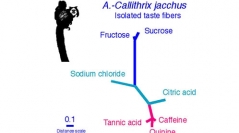

 Comptes Rendus Palevol
2 (4) - Pages 281-287
Comptes Rendus Palevol
2 (4) - Pages 281-287This paper presents a parallel analysis of the results of recent studies of taste responses of humans and phylogenetically different non-human primates, in order to provide evidence of the evolutionary history of taste perception, and to discuss its present significance. A cluster analysis of the signals recorded on isolated nerve fibres of the various non-human primates shows additive trees representations, corresponding to a two-way system that allows discriminating what is beneficial from what could be toxic or anti-nutrient (sugars vs. alkaloids and tannins) among a large number of chemical stimuli. In humans, using psychophysical data (recognition taste thresholds) with a similar method of analysis, we observed the same dichotomy in the additive tree and similar covariation between some tastes thresholds, notably those of alkaloids and tannins. The converging results obtained by both methods show that the target of evolutionary pressure was a set of taste receptors that were not initially tuned to respond to what is presently described as basic tastes.
Gustatory nerves, basic tastes, recognition thresholds, sugars, tannins, alkaloids